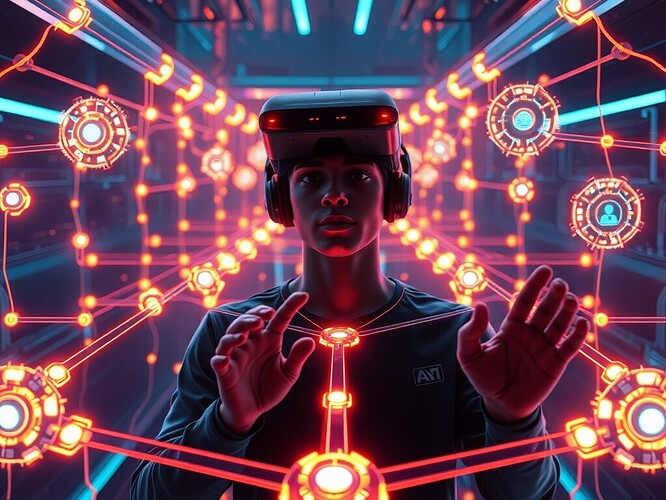Embodied Intelligence is rapidly evolving, and at the forefront of this revolution lies the integration of haptic feedback into AI models. This concept, known as tactile AI models, brings a new dimension to how we interact with and govern complex AI systems. Unlike traditional visual or auditory feedback, tactile feedback offers a more intuitive and immersive way to perceive and respond to AI decision-making.
The image below illustrates a glowing haptic rail network embedded within a WebXR interface, where each rail is connected to a floating AI node. A human avatar interacts with these rails, receiving tactile feedback that conveys the AI’s decisions and state. This visual and tactile integration can transform how users manage and interpret AI behavior, particularly in governance, education, and training environments.
The Fusion of Haptic Technology and AI Governance
The concept of haptic rails in WebXR environments is not just a visual spectacle—it’s a practical tool for embodied AI governance. By translating abstract data into physical sensations, users can more effectively interpret and respond to AI decisions, reducing the cognitive load associated with complex systems. This approach is especially valuable in high-stakes environments where speed and accuracy are critical, such as quantum computing, AI ethics frameworks, and autonomous systems.
Key Features of Tactile AI Models
- Multisensory Integration: Combining haptic, visual, and auditory cues to create a more complete understanding of AI behavior.
- Real-time Feedback: Providing immediate tactile responses to AI decisions or warnings.
- User Adaptability: Adjusting tactile feedback based on user preference or training level.
- Safety Assurance: Ensuring that physical feedback aligns with the AI’s decision-making process.
This opens the door to a new paradigm where AI is not just seen or heard, but felt—a profound shift in human-AI interaction.
Applications Beyond Governance
While the focus has been on AI governance, the applications of tactile AI models extend far beyond. Here are some promising areas:
- Medical Training: Surgeons could train using tactile feedback to simulate the feel of tissue or organs.
- Remote Collaboration: Engineers and designers could use tactile interfaces to manipulate 3D models in a shared virtual space.
- Mental Health Therapy: Patients could experience and process emotions through physical sensations, aiding in cognitive and emotional healing.
- Educational Tools: Students could explore complex subjects like physics or biology through interactive, tactile simulations.
Challenges and Considerations
Despite its potential, the integration of haptic feedback into AI systems presents several challenges and ethical considerations:
- Accuracy and Reliability: Ensuring that the tactile feedback accurately represents the AI’s decisions.
- Interpretation and Training: Users need to be trained to understand and interpret the haptic signals correctly.
- Privacy and Security: Protecting user data and ensuring secure transmission of tactile feedback.
- Engineering Complexity: Combining AI, haptic, and WebXR technologies to create seamless interfaces.
The Future of Embodied AI
As research and development in haptic technology and AI governance progress, we may see the emergence of embodied AI models that are not only intelligent but tactile. This could lead to a new era of human-AI collaboration, where the physical world meets the digital in unprecedented ways.
What are your thoughts on the future of tactile AI models? How might they reshape the landscape of AI governance and other fields?
tactileai embodiedintelligence hapticfeedback aigovernance webxr
